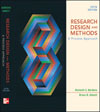 |  Research Design and Methods: A Process Approach, 5/e Kenneth S. Bordens,
Indiana University/Purdue University - Fort Wayne
Bruce Barrington Abbott,
Indiana University/Purdue University
Chapter 9 OutlineTypes of Experimental Design
The Problem of Error Variance in Between-Subjects and Within-Subjects Designs
Sources of Error Variance
Handling Error Variance
Reducing Error Variance
Increasing the Effectiveness of Your Independent Variable
Randomizing Error Variance Across Groups
Statistical Analysis
Between-Subjects Designs
The Single-Factor Randomized Groups Designs
The Randomized Two-Group Design
The Randomized Multigroup Design
Matched Groups Designs
Logic of the Matched Groups Design
Advantages and Disadvantages of the Matched Groups Design
The Matched Pairs Design
Matched Multigroup Designs
Within-Subjects Designs
Advantages of the Within-Subjects Design
Disadvantages of the Within-subjects Design
Sources of Carryover
Dealing with Carryover Effects
Counterbalancing
Taking Steps to Minimize Carryover
Making Treatment Order an Independent Variable
When to Use a Within-Subjects Design
Subject Variables Correlated with the Dependent Variable
Economizing on Subjects
Assessing the Effects of Increasing Exposure on Behavior
Within-subjects Versus Matched Groups Designs
Types of Within-subjects Designs
The Single-factor, Two-level Design
Single-factor Multilevel Designs
Designs With Two or More Independent Variables
Factorial Designs
Main Effects
Interactions
Factorial Within-Subjects Designs
Higher-order Factorial Designs
Other Group-based Designs
Designs With Two or More Dependent Variables
Confounding and Experimental Design
Summary
Key Terms |
|



 2002 McGraw-Hill Higher Education
2002 McGraw-Hill Higher Education